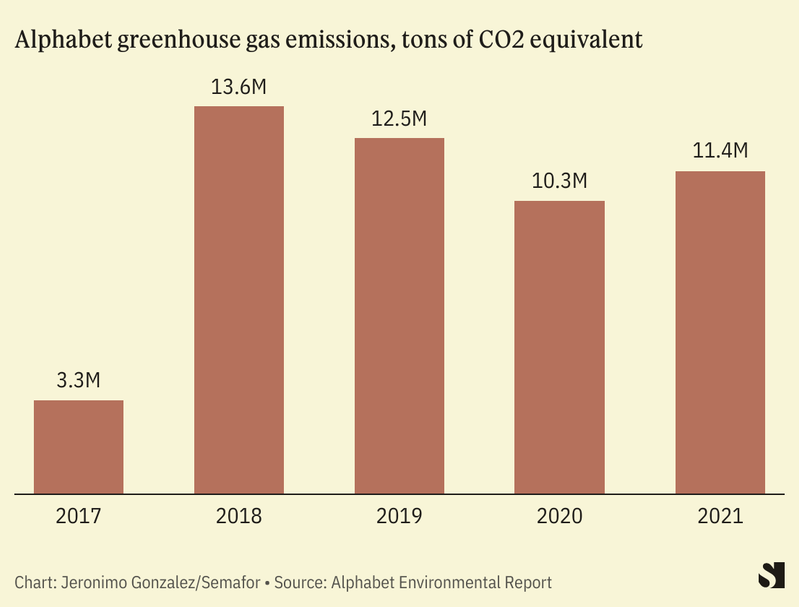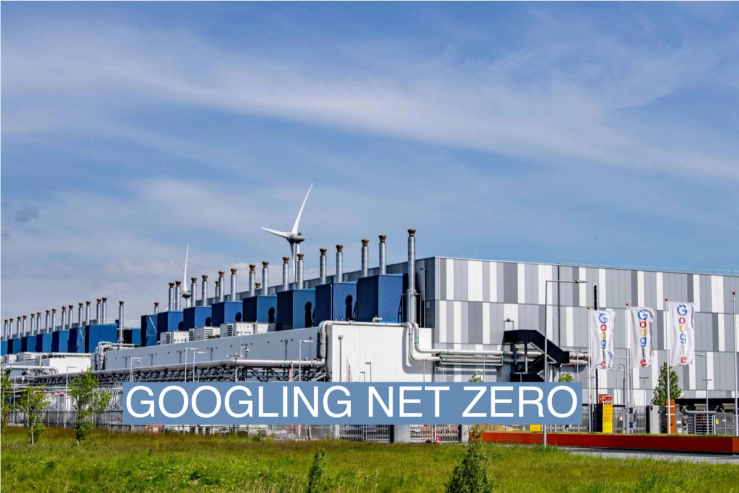The Facts
Google has one of the corporate world’s most ambitious climate targets, aiming to reach net zero by 2030 for all its operational and supply-chain emissions. It broke new ground in how it aims to procure clean electricity, becoming the first company to commit to buying around-the-clock, locally-produced clean energy in 2021.
The person responsible for that effort is Michael Terrell, Google’s senior director for energy and climate. In an interview, he told me utilities and energy companies are repackaging their products to help corporate buyers meet their climate goals, but that permitting reform remains a big obstacle.
In this article:
Tim’s view
One key measure of the success of Google’s net zero journey will be how much it has to rely on carbon offsets by its deadline of 2030. At the moment, Terrell said, that could be as much as half of the company’s total footprint, mostly to cover leftover emissions from chip manufacturers and other hardware suppliers.
Relative to other tech companies, Google has disclosed fewer details about its supply chain emissions and how it will reduce them, said Thomas Day, an analyst at the NewClimate Institute, a think tank, who authored a February report criticizing Google’s Scope 3 (supply chain) emissions plans: “They are trying to push the envelope, but at the same time they’re exaggerating some claims,” Day told me, because of how much is really being covered by offsets. Another uncertainty: Will Google be able to source enough high-quality carbon removal credits, or have to cover much of its 2030 emissions gap with lower-quality offsets?

The Interview
Tim: What is Google’s vision for itself in 2030?
Michael: Google’s focus in the early days was our electricity consumption, because that was the biggest part of our carbon footprint. Our net zero goal is much bigger than that. It encompasses our scope one, scope two, and scope three footprints, for a 2030 goal against the 2019 baseline. Our company has grown from year to year as the internet has grown, so it’s an ambitious target.
Tim: Compared to 15 years ago when you started working on climate, how would you say the pace of change has accelerated in that time?
Michael: When I started in 2007, we put a 1.6 megawatt solar installation on top of our headquarters building. At the time it was the largest corporate solar installation in the world. We’ve now signed contracts for over 7,000 megawatts of renewables. We pioneered efforts to go out beyond our rooftops and go straight to developers and sign all-day contracts for huge solar and wind farms.
Another point is the year I started, we had an initiative that was trying to promote EVs. At the time there were no EVs in the market and we actually had engineers take a Toyota Prius [and] manually convert it into a plug-in. Now I look out my window at Google and there’s 200 charging stations and EVs all over the road. We’ve really reached the tipping point with that. So I think that’s encouraging in terms of how quickly the technology can advance. That’s why I like setting these goals that seem unattainable, it does inspire you to solve these problems.
Tim: You said some steps on the path to net zero are still unclear. Can you expand on that?
Michael: The existing technologies that we have now, we need to find ways to get them built and deployed faster. When we sign a contract for wind and solar now, it takes three or four years for that project to get built. We’ve got to speed that up.
There are some parts of the world, like Asia, for example, where it’s really difficult to get renewable energy projects built. For a host of market reasons that geography is more challenging and constraining. So we’ve got to find ways to solve for tough regions. And we need to find new tech that will fill some of the gaps left by wind, solar, and lithium-ion storage, like green hydrogen or long-duration storage. The hardest challenges are in scope three and the value chain. Decarbonizing our hardware supply chains is an area that’s super difficult and one that we’re working on now.
Tim: There’s not very much time left on the clock to figure those things out before 2030.
Michael: It still feels like a moonshot. But we think it’s achievable. We want to be a force multiplier. I chair the board of an organization called the Clean Energy Buyers Association, which now has more than 400 companies that are trying to do renewable energy procurement at scale. So we’ve been helping to address some of the barriers we see with permitting and getting transmission built and projects interconnected.
We’ve changed the way we sign contracts for clean energy. We used to just go to a wind developer and say: ‘sell us your wind.’ Now we’re going to energy providers and saying, ‘give us a portfolio of projects that meets X percentage of carbon-free energy.’ So they’re changing the way they sell their product. We’re encouraged by the adoption of tools that allow us to track our clean energy purchases on an hourly and locational basis. We invented a new tracking mechanism called a time-based energy attributes certificate, and there’s an organization called EnergyTag based out of London that’s developing principles for how renewable energy tracking agencies around the world can start to make this transition to hourly certificates.
Less than 10 years ago there wasn’t a utility in the U.S. that offered a green energy or clean energy purchase program at high volumes for companies. Now I don’t think you can be a utility and not have clean energy offerings for companies. That’s something that we’ve been a champion for. In markets that are deregulated, where sellers have more freedom to package different offerings, we’re starting to see them put together 24/7 tailored solutions for companies like us. We’ve now done this for our Virginia data centers, and in Europe.
Tim: Can you say more about the particular challenges for scope 3?
Michael: It’s areas where we don’t have as much direct control. The largest one by far is the electronic hardware supply chains: Pixel phones, or servers that go into our data centers. There are three things you’ve got to do. The first is helping suppliers with their transition to clean energy, to help them transition their own manufacturing facilities. Second, we’ve got to look at ways to decarbonize manufacturing processes. And third, to decarbonize the materials we use. Another area of our scope three footprint would be steel and concrete for the construction of our data centers. These are challenges that almost all companies are facing.
Tim: How do carbon offsets fit into this program? Are you changing how you use these given all the criticisms that have been raised about the integrity of the voluntary carbon market?
Michael: Certainly there will be a residual amount of emissions that will need to be covered with carbon removals. We’re starting to look at how we can help to advance that space, because it’s still nascent. We were a founding member of the Frontier carbon partnership with Stripe and other companies, where we basically say: ‘if you build it, we will buy it.’ So we’re making early purchase commitments to get these technologies to scale faster.
Tim: So by 2030, what portion of the remaining footprint do you expect will need to be removed or offset versus direct reductions?
Michael: We’ll do at least half of the reductions off our 2019 baseline through direct activities across our operations and value chain, and then do the rest through carbon removals.


